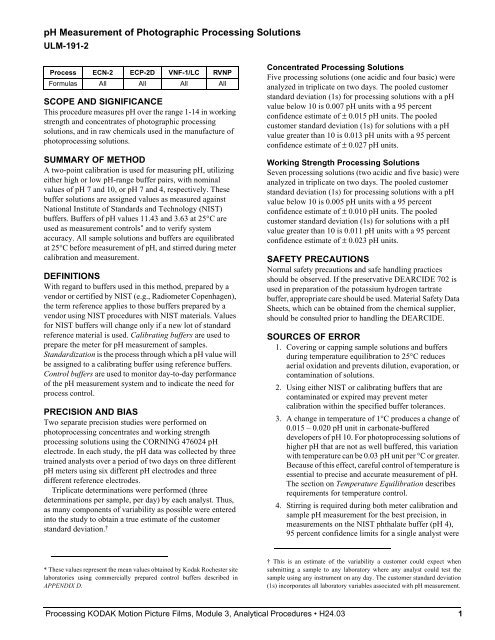Processing kodak motion picture films, module 3 analytical procedures
Processing kodak motion picture films, module 3 analytical procedures
Processing kodak motion picture films, module 3 analytical procedures
You also want an ePaper? Increase the reach of your titles
YUMPU automatically turns print PDFs into web optimized ePapers that Google loves.
pH Measurement of Photographic <strong>Processing</strong> Solutions<br />
ULM-191-2<br />
Process ECN-2 ECP-2D VNF-1/LC RVNP<br />
Formulas All All All All<br />
SCOPE AND SIGNIFICANCE<br />
This procedure measures pH over the range 1-14 in working<br />
strength and concentrates of photographic processing<br />
solutions, and in raw chemicals used in the manufacture of<br />
photoprocessing solutions.<br />
SUMMARY OF METHOD<br />
A two-point calibration is used for measuring pH, utilizing<br />
either high or low pH-range buffer pairs, with nominal<br />
values of pH 7 and 10, or pH 7 and 4, respectively. These<br />
buffer solutions are assigned values as measured against<br />
National Institute of Standards and Technology (NIST)<br />
buffers. Buffers of pH values 11.43 and 3.63 at 25°C are<br />
used as measurement controls * and to verify system<br />
accuracy. All sample solutions and buffers are equilibrated<br />
at 25°C before measurement of pH, and stirred during meter<br />
calibration and measurement.<br />
DEFINITIONS<br />
With regard to buffers used in this method, prepared by a<br />
vendor or certified by NIST (e.g., Radiometer Copenhagen),<br />
the term reference applies to those buffers prepared by a<br />
vendor using NIST <strong>procedures</strong> with NIST materials. Values<br />
for NIST buffers will change only if a new lot of standard<br />
reference material is used. Calibrating buffers are used to<br />
prepare the meter for pH measurement of samples.<br />
Standardization is the process through which a pH value will<br />
be assigned to a calibrating buffer using reference buffers.<br />
Control buffers are used to monitor day-to-day performance<br />
of the pH measurement system and to indicate the need for<br />
process control.<br />
PRECISION AND BIAS<br />
Two separate precision studies were performed on<br />
photoprocessing concentrates and working strength<br />
processing solutions using the CORNING 476024 pH<br />
electrode. In each study, the pH data was collected by three<br />
trained analysts over a period of two days on three different<br />
pH meters using six different pH electrodes and three<br />
different reference electrodes.<br />
Triplicate determinations were performed (three<br />
determinations per sample, per day) by each analyst. Thus,<br />
as many components of variability as possible were entered<br />
into the study to obtain a true estimate of the customer<br />
standard deviation. †<br />
* These values represent the mean values obtained by Kodak Rochester site<br />
laboratories using commercially prepared control buffers described in<br />
APPENDIX D.<br />
Concentrated <strong>Processing</strong> Solutions<br />
Five processing solutions (one acidic and four basic) were<br />
analyzed in triplicate on two days. The pooled customer<br />
standard deviation (1s) for processing solutions with a pH<br />
value below 10 is 0.007 pH units with a 95 percent<br />
confidence estimate of ± 0.015 pH units. The pooled<br />
customer standard deviation (1s) for solutions with a pH<br />
value greater than 10 is 0.013 pH units with a 95 percent<br />
confidence estimate of ± 0.027 pH units.<br />
Working Strength <strong>Processing</strong> Solutions<br />
Seven processing solutions (two acidic and five basic) were<br />
analyzed in triplicate on two days. The pooled customer<br />
standard deviation (1s) for processing solutions with a pH<br />
value below 10 is 0.005 pH units with a 95 percent<br />
confidence estimate of ± 0.010 pH units. The pooled<br />
customer standard deviation (1s) for solutions with a pH<br />
value greater than 10 is 0.011 pH units with a 95 percent<br />
confidence estimate of ± 0.023 pH units.<br />
SAFETY PRECAUTIONS<br />
Normal safety precautions and safe handling practices<br />
should be observed. If the preservative DEARCIDE 702 is<br />
used in preparation of the potassium hydrogen tartrate<br />
buffer, appropriate care should be used. Material Safety Data<br />
Sheets, which can be obtained from the chemical supplier,<br />
should be consulted prior to handling the DEARCIDE.<br />
SOURCES OF ERROR<br />
1. Covering or capping sample solutions and buffers<br />
during temperature equilibration to 25°C reduces<br />
aerial oxidation and prevents dilution, evaporation, or<br />
contamination of solutions.<br />
2. Using either NIST or calibrating buffers that are<br />
contaminated or expired may prevent meter<br />
calibration within the specified buffer tolerances.<br />
3. A change in temperature of 1°C produces a change of<br />
0.015 – 0.020 pH unit in carbonate-buffered<br />
developers of pH 10. For photoprocessing solutions of<br />
higher pH that are not as well buffered, this variation<br />
with temperature can be 0.03 pH unit per °C or greater.<br />
Because of this effect, careful control of temperature is<br />
essential to precise and accurate measurement of pH.<br />
The section on Temperature Equilibration describes<br />
requirements for temperature control.<br />
4. Stirring is required during both meter calibration and<br />
sample pH measurement for the best precision, in<br />
measurements on the NIST phthalate buffer (pH 4),<br />
95 percent confidence limits for a single analyst were<br />
† This is an estimate of the variability a customer could expect when<br />
submitting a sample to any laboratory where any analyst could test the<br />
sample using any instrument on any day. The customer standard deviation<br />
(1s) incorporates all laboratory variables associated with pH measurement.<br />
<strong>Processing</strong> KODAK Motion Picture Films, Module 3, Analytical Procedures H24.03 1
















